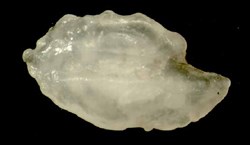In the early 1970s, pink salmon runs in Prince William Sound had crashed. An aggressive enhancement program was developed that included the construction of hatcheries. By 1986, there were five hatcheries operating in Prince William Sound, releasing hundreds of millions of salmon annually. These hatcheries needed to be able to distinguish hatchery-raised fish from wild fish, to be sure that not too many wild fish were being caught. Fisheries managers began marking the hatchery fish with coded wire tags, but inserting and reading coded wire tags is time consuming, expensive and requires a large sample size.
 The Trustee Council provided funding to provide Prince William Sound hatcheries with heaters to create thermal marks on pink salmon otoliths. Otoliths are hard, bone-like structures located directly behind the brain of bony fishes. Visible rings on thin cross-sections can be used to age fish. Thermal marks are created by heating the water temperatures when the fish are embryos to produce distinct bar code-like patterns on the otolith. The marks are preserved in the otoliths of adult fish. They are relatively inexpensive to apply and all fish in a hatchery can be marked without harm. The use of thermal marking (instead of wire tags) provides fisheries managers more accurate information at a reduced cost, allows fisherman to target hatchery fish, and ensures that wild stocks are not overfished. Thermal marking has been used by researchers to identify Prince William Sound salmon in the high seas and to investigate factors that influence marine survival. Because so many Alaskan hatcheries are located in Prince William Sound, this investment had significant results.
The Trustee Council provided funding to provide Prince William Sound hatcheries with heaters to create thermal marks on pink salmon otoliths. Otoliths are hard, bone-like structures located directly behind the brain of bony fishes. Visible rings on thin cross-sections can be used to age fish. Thermal marks are created by heating the water temperatures when the fish are embryos to produce distinct bar code-like patterns on the otolith. The marks are preserved in the otoliths of adult fish. They are relatively inexpensive to apply and all fish in a hatchery can be marked without harm. The use of thermal marking (instead of wire tags) provides fisheries managers more accurate information at a reduced cost, allows fisherman to target hatchery fish, and ensures that wild stocks are not overfished. Thermal marking has been used by researchers to identify Prince William Sound salmon in the high seas and to investigate factors that influence marine survival. Because so many Alaskan hatcheries are located in Prince William Sound, this investment had significant results.
